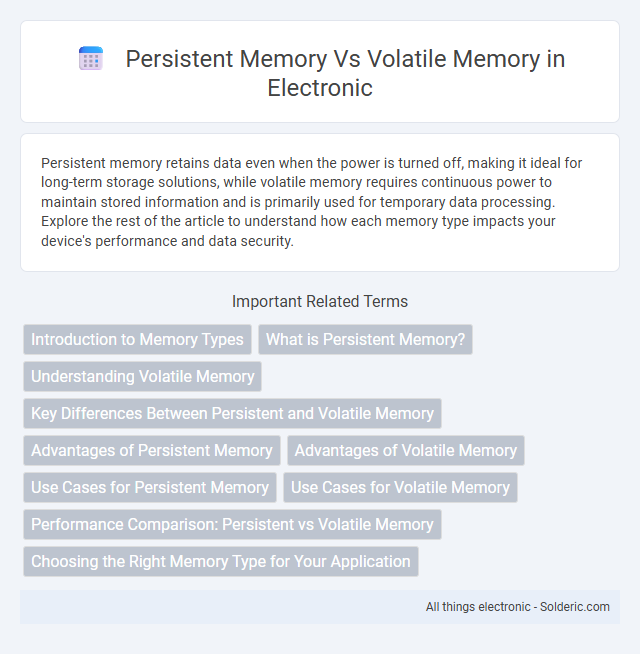Persistent memory retains data even when the power is turned off, making it ideal for long-term storage solutions, while volatile memory requires continuous power to maintain stored information and is primarily used for temporary data processing. Explore the rest of the article to understand how each memory type impacts your device's performance and data security.
Comparison Table
| Feature | Persistent Memory | Volatile Memory |
|---|---|---|
| Data Retention | Retains data without power | Data lost when power is off |
| Speed | Slower than volatile memory, faster than traditional storage | Fastest memory type, low latency |
| Use Cases | Database caching, fast storage, memory expansion | Primary system memory (RAM), CPU cache |
| Examples | Intel Optane DC Persistent Memory, 3D XPoint | DRAM, SRAM |
| Cost | Higher cost per GB than volatile memory | Lower cost per GB, widely available |
| Power Consumption | Consumes power to maintain state, but data persists without power | Consumes power continuously to preserve data |
Introduction to Memory Types
Persistent memory retains data even when power is lost, making it ideal for long-term storage and faster data retrieval compared to traditional non-volatile storage like SSDs. Volatile memory, such as DRAM, requires continuous power to maintain stored information and offers high-speed access necessary for active processes and applications. The fundamental difference lies in data retention capabilities, influencing system performance and data persistence strategies in computing environments.
What is Persistent Memory?
Persistent memory is a type of non-volatile storage that retains data even when power is lost, combining the speed of traditional RAM with the durability of storage drives. It enables faster data access and enhances application performance by bridging the gap between volatile memory and slower storage. You can leverage persistent memory to accelerate workloads and improve system efficiency in environments requiring rapid data retrieval and high availability.
Understanding Volatile Memory
Volatile memory, such as DRAM, requires continuous power to retain data, leading to data loss upon power interruption. It offers high-speed access and low latency, making it ideal for active processing tasks and temporary storage in computing systems. Understanding volatile memory's limitations and performance characteristics is crucial for optimizing system memory hierarchy and balancing speed with data persistence.
Key Differences Between Persistent and Volatile Memory
Persistent memory retains data even when power is lost, making it suitable for long-term storage solutions like solid-state drives and non-volatile RAM. Volatile memory, such as DRAM, requires constant power to maintain stored information and is primarily used for temporary data storage during active computing processes. Understanding these key differences helps you optimize system performance and data reliability based on your specific memory needs.
Advantages of Persistent Memory
Persistent memory offers significant advantages by combining the speed of traditional volatile memory with the durability of storage devices, allowing data to be retained even when power is lost. This non-volatile nature reduces data loss risks and enables faster system recovery and improved application performance. Your computing experience benefits from persistent memory through enhanced data reliability and reduced latency in accessing critical information.
Advantages of Volatile Memory
Volatile memory offers significantly faster data access speeds compared to persistent memory, making it ideal for temporary data storage and real-time processing tasks. Its ability to quickly read and write data enhances overall system performance, especially in applications requiring rapid data retrieval. The lower cost and widespread availability of volatile memory, such as DRAM, support efficient scalability in computing environments.
Use Cases for Persistent Memory
Persistent memory is ideal for use cases requiring high-speed data access combined with data durability, such as real-time analytics, in-memory databases, and transactional processing systems. It enhances application performance by providing near-DRAM speeds with non-volatility, enabling faster recovery after power loss or system crashes. Your critical workloads benefit from persistent memory by minimizing data loss risks and improving uptime in enterprise environments.
Use Cases for Volatile Memory
Volatile memory, such as DRAM, is ideal for use cases requiring high-speed data access and temporary storage, including running operating systems, active application processes, and real-time data manipulation. It supports fast read/write cycles essential for gaming, multimedia editing, and complex computations where data persistence is not necessary after power loss. Your system's efficient multitasking and quick program responsiveness rely heavily on the low latency and volatility characteristics of this memory type.
Performance Comparison: Persistent vs Volatile Memory
Volatile memory, such as DRAM, offers significantly faster data access speeds with latencies in the nanosecond range, making it ideal for active computing tasks requiring rapid read/write operations. Persistent memory, including technologies like Intel Optane DC Persistent Memory, provides non-volatile data retention with slightly higher latencies, typically tens to hundreds of nanoseconds, while enabling data preservation across power cycles. The performance trade-off favors volatile memory in raw speed, but persistent memory excels in data durability and reduces storage bottlenecks by combining near-DRAM speed with non-volatility.
Choosing the Right Memory Type for Your Application
Persistent memory retains data even when power is off, making it ideal for applications requiring data durability and fast recovery times. Volatile memory offers faster read/write speeds but loses all stored information when power is lost, suitable for high-speed processing and temporary data storage. Your choice depends on whether your application prioritizes data persistence or rapid access and processing speed.
persistent memory vs volatile memory Infographic

 solderic.com
solderic.com